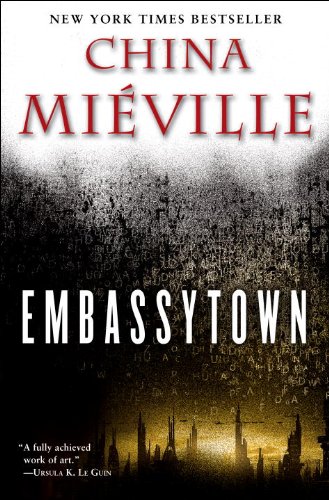When I first read China Miéville’s Embassytown, which I now regard as a nearly perfect novel, I didn’t get it. The story seemed to move quite nicely to an anticlimax, I thought, where a potential massacre turns on a dime because of language. My fault – I was expecting the normal sort of adventure and forgot this was a book by China Miéville, one of the least predictable and most original writers of our time. In this reading, I loved the whole story, so that when I got to that climactic scene, I could feel a thrilling breakthrough.
Partly, Miéville achieves the emotional effect of the story by telling it as a first person narrative through the eyes of Avice Benner Cho, who prides herself on being a floaker. That term, one of Miéville’s many invented words, refers to someone practicing “the life-technique of aggregated skill, luck, laziness and chutzpah.” It fits Avice as a narrator quite well. She is someone who observes keenly, keeps a certain emotional distance from key events, but is brash and skillful enough to intervene effectively in crisis when she has to.
Avice comes from Arieka, where a colonizing planet called Bremen has established a human colony amid the race of Ariekei. For ages, the two species had no way to communicate because the Ariekei don’t speak anything humans would call a language. But after megahours (hours is the preferred way to express time in this universe) of experimenting, they train and surgically alter pairs of humans to speak simultaneously in a way that mimics the double-tongued Arieki speech, at least enough so that they two species can begin to communicate.
Eventually, Embassytown clones its own pairs of people that achieve higher levels of speech recognition. The pairs of speakers, with names like CalVin or DalTon to indicate how inseparable they are, become Ambassadors, the only ones who can speak to the Ariekei, called the Hosts. Miéville created a special notation to convey something of the complexity of Ariekei speech by writing one word or part of a name over another separated by a bar, indicating the multiple simultaneous vocalizations of the Hosts and the, hopefully, perfectly blended sounds of the Ambassadors. On the audio recording, they use a sound like a single brief organ tone. If you’ve ever listened to slowed-down recordings of bird calls, you can get an even better idea of what sounds are like from multiple sets of vocal cords blended together in one complex song.
The depiction of the Ariekei is one of the most successful renderings of an alien species I’ve ever encountered. Their physical form is a bit mysterious since we never get a complete head-to-toe (well, minus a recognizable head and with hooves instead of toes) description but lots of intriguing details. They are taller than humans with a mouth or two about human chest-height, eyes on stalks, a wing, rippling with colors, that unfolds from its back and that contains its organs of hearing, another wing that grasps things, four “too-jointed” legs with hooves, and I’m not sure what else.
But it is their language, of course, that is even more alien. It isn’t really language in our sense at all since they do not separate meanings from the sounds they articulate or use words as symbols. They cannot lie and can only grasp what is said to them when there is a mind producing the complex sounds they can understand in the moment. They make comparisons of one thing with another by having someone enact a simile. Avice, when still a child, was invited by the Hosts to become a simile in this way. As one character explains his conception of the Hosts’ Language:
“Hosts’ minds were inextricable from their doubled tongue. They couldn’t learn other languages, couldn’t conceive of their existence, or that the noises we made to each other were words at all. A Host could understand nothing not spoken in Language, by a speaker, with intent, with a mind behind the words.”
Embassytown, Kindle edition, Location 802
After many years of the system of cloned Ambassadors working well under Embassytown control, Bremen decides to send a new Ambassador, named EzRa, who were trained up in a different way. When they are introduced to the Hosts at a gala event, the Ariekei have a strange reaction. As becomes apparent over time, most of them get addicted to the sound of EzRa speaking. The content is irrelevant. The Hosts are hooked, and relations between the species become chaotic.
The story then takes off, as waves of addiction consume the Hosts, followed by a violent reaction of Ariekei who mutilate themselves to prevent their hearing anything. They start a rebellion to wipe out all the addicted and all the humans with them. The whole system that sustains life on the planet begins to fail in the mass destruction.
The Ariekei system of construction is another strange touch, since their buildings and infrastructure for everything from farming to transportation, is made of bio-materials that seem to have a life of their own. Buildings breathe and react to stress. Food supplies arrive in living cities by means of flexible tubes that seem to operate like intestines. Humans cannot breathe the atmosphere of the planet and can only visit Ariekei towns with special masks. The whole of Embassytown is covered by a kind of bubble of human-adjusted air. When rebellion begins to destroy the bases of life, the built environment feels the suffering and begins to decay.
In a way, Embassytown also works as a critique of colonialism. Addiction is an interesting metaphor for the kind of internalized oppression that draws colonized peoples into the cultural and economic orbit of more powerful countries (or planets). Language too can become an infiltrating force that overturns local customs and influences new patterns of behavior.
However you might look at Embassytown, it’s a novel rich in meaning and wonderfully detailed in its execution. While it is a novel of ideas, it’s never didactic but tells its story through fascinating characters who are thrown into demanding situations that take all their wits and courage to survive.





Leave a Reply